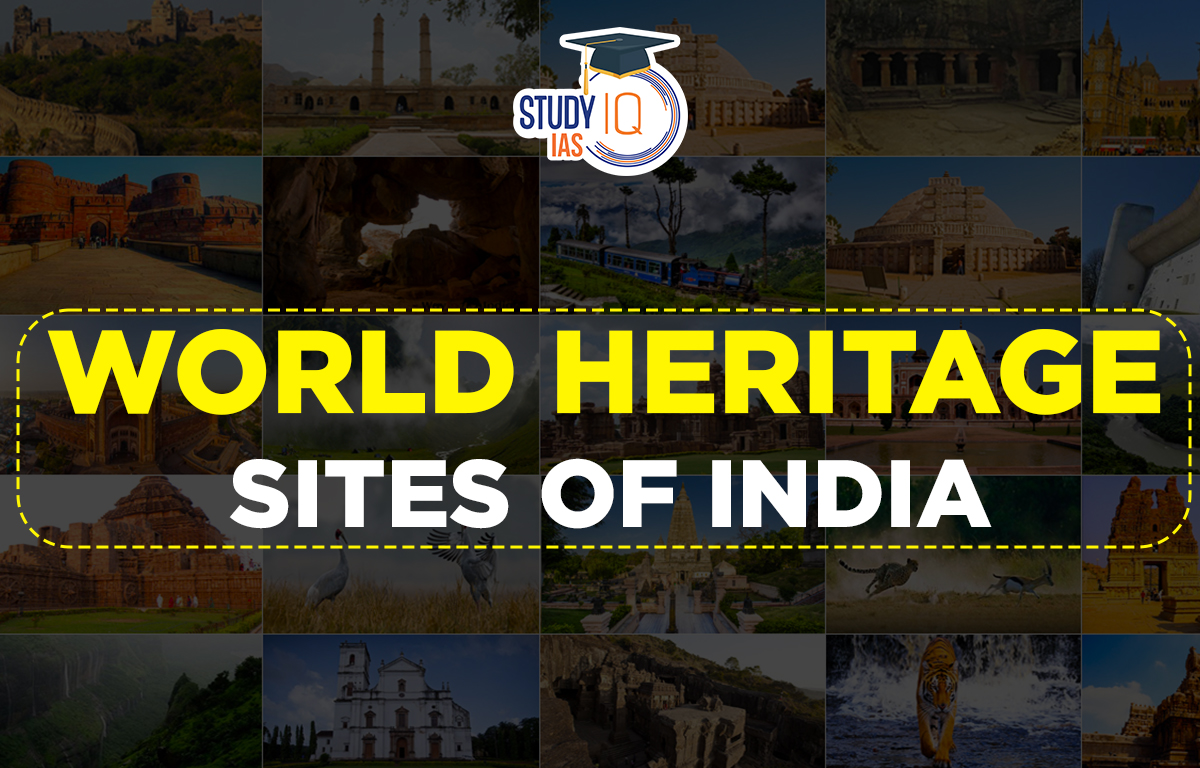| Name of the Site |
Added on Year |
Importance |
| Kaziranga National Park |
1985 |
- It has the world’s largest number of one-horned rhinos.
- Other animals include Elephants, wild water buffalo, and swamp deer.
- It is also an Important Bird Area by BirdLife International, an Elephant Reserve under Project Elephant.
- It has the highest density of tigers among protected areas in the world and was made a Tiger Reserve in 2006.
- The vegetation here includes a vast expanse of tall elephant grass, marshland and dense tropical moist broadleaf forest
|
| Manas National Park |
1985 |
- It is a Wildlife sanctuary, Tiger Reserve, Elephant Reserve and Biosphere Reserve.
- Situated close to the Himalayan foothills, near to Royal Manas National Park in Bhutan.
- It is known for its rare endemic species,
- Critically endangered – pigmy hog
- Endangered – Assam roofed turtle, hispid hare and golden langur
|
| Mahabodhi Temple Complex at Bodh Gaya |
2002 |
- Emperor Ashoka built the first temple around the Bodhi tree.
- The present temple is dated between the 5th and 6th centuries AD.
- It is built of bricks.
- It is the oldest temple in the Indian subcontinent, built during the Gupta Period.
- Some parts of the structure are preserved in the museum.
|
| Humayun’s Tomb |
1993 |
- Considered a precursor to the Taj Mahal.
- It was built in 1569-70 by Humayun’s widow, Biga Begum.
- Its architecture was created by Mirza Ghiyath and its Mughal architectural style has been acclaimed as a “necropolis of the Mughal dynasty”, for its double-domed elevation provided with Chhatris.
- The tomb is set on an irregular octagonal plinth.
- The tomb is built with a char-bagh layout with two gates, one on the south and the other on the west, a pavilion and a bath.
|
| Qutub Minar Complex |
1993 |
- Red sandstone tower of 72.5 m in height.
- Built at the beginning of the 13th century.
- The complex structure comprises
- Alai Darwaza
- Alai Minar
- Qubbat-ul-Islam mosque
- Tomb of Iltumish
- Iron Pillar
- Structures have been made from the remains of Hindu and Jain temples.
- The iron pillar has inscriptions in Sanskrit belonging to Chandra Gupta II’s period.
- Work started by Qutubuddin Aibak in 1192, completed by Iltutmish and again by Alauddin Khalji.
|
| Red Fort |
2007 |
- Built by Emperor Shah Jahan as part of his new capital city of Shahjahanabad.
- A prominent example of Indo-Islamic architecture
- Planning and design of this complex in a geometrical grid plan with pavilion structures was the precursor of several monuments which were built later in Rajasthan, Delhi and Agra
- It is adjacent to Salimgarh fort on its north, built by Islam Shah Suri in 1546 and is now a part of the Red Fort complex
- Other important constructions in this complex include Diwan-i-Am, Diwan-i-khas, Nehr-i-Behishit, Moti Masjid (built by emperor Aurangzeb)
|
| Churches of Goa |
1986 |
- They were built between the 16th and 18th centuries by the Portuguese who ruled Goa during this time.
- Monuments are mainly in the former capital of Velha Goa or Old Goa
- Basilica of Bom Jesus – known for housing the remains of St. Francis Xavier
- Only some of the original monuments have survived, which include :
- Saint Catherine’s Chapel – where one of the first Latin rite masses in Asia was held on Saint Catherine’s feast day, i.e. 25 Nov 1510.
- Saint Francis of Assisi Church
- Basilica of Bom Jesus
- Church of Saint Cajetan and its seminary
- Church of Our Lady of Rosary
- Church of Saint Augustine
- Structures are built using laterite rocks and lime plaster
- For this reason, they need constant maintenance and protection
|
| Champaner-Pavagarh |
2004 |
- Situated in the Panchmahal district of Gujarat.
- It is a late Stone Age site. It also has a hill fortress which belongs to ancient Hindu rulers.
- Kalikamata Temple, on top of Pavagarh Hill, attracts a large number of devotees
- This site is the only complete Islamic pre-Mughal city.
|
| Monuments of Hampi |
1986 |
- Hampi town is located on the bank of the river Tungabhadra in Karnataka.
- The site consists of remains from the Vijayanagara times.
- Many travellers between the 14th and 16th centuries mentioned it in their travelogues.
- Virupaksha Temple and several other monuments.
- Vittala Temple is known for its musical pillars.
|
| Pattadakal Monuments |
1987 |
- The complex consists of Hindu and Jain temples. It is located in northern Karnataka.
- Virupaksha Temple
- Built in 740 by Queen Lokamahadevi
- To mark the victory of King Vikramaditya II (her husband) over the Pallava ruler.
- A combination of temples built by the Chalukya Dynasty in the 6th and 8th centuries at Aihole, Badami and Pattadakal.
- Temples represent the fusion of the Nagara and Dravida styles
- Within the heritage complex
- Eight temples dedicated to Shiva
- Ninth Shaivite sanctuary called Papanath Temple
- A Jaina temple
|
| Sanchi, Madhya Pradesh |
1989 |
- Monuments dated around the 2nd century BC
- Built during the time of Emperor Ashoka
- Historically, it was a Buddhist religious site and remained active till about the 12th century.
- The complex has many monolithic pillars, temples and monasteries in different states of preservation
|
| Bhimbetka Rock Shelter |
2003 |
- Located at the foothills of the Vindhyan range
- They are sandstone shelters extending over an area of over 25,000 acres
- Shelters have paintings dated from Palaeolithic to Neolithic times.
- Villages surrounding them reflect the tradition displayed in rock paintings
|
| Khajuraho Temples |
1986 |
- Built by rulers of the Chandela dynasty.
- Monuments belong to the Hindu and Jain religions.
- Of the 85 temples built, only 22 have survived, including Khandariya Temple.
- Temples are famous for their nagara-style of architecture and their erotic sculptures.
|
| Ajanta Caves |
1983 |
- Buddhist caves
- Built in two phases
- The first phase from the 2nd century BC
- The second phase, between the 5th and 6th centuries AD, of the Gupta period
- Depict richly decorated paintings and frescoes similar to Sigiriya paintings in Sri Lanka
|
| Ellora Caves |
1983 |
- Located in the Aurangabad district of Maharashtra
- The cultural mix of three religions, Buddhism, Hinduism and Jainism, can be seen here.
- Structures have been carved in basalt rocks
- Kailash temple is the most admired among them, which was built by Krishna I of the Rashtrakuta dynasty.
- Structures are dated from 600 to 1000 AD
|
| Elephanta Caves |
1987 |
- Group of caves located on Elephanta Island or Gharapuri
- The islands are located near the western coast of India in the Arabian Sea
- It consists of two groups of caves
- The first group consist of Hindu caves
- The second group consist of Buddhist caves
- Hindu caves have sculptures of Shiva
- Caves are cut in basalt formations
|
| Chhatrapati Shivaji Terminus |
2004 |
- At present, Central Railways’ headquarters are located here.
- The station was designed in Gothic style in 1887-1888 by Frederick William Stevens and was built as the headquarters of the Great Indian Peninsular Railway.
|
| Sun Temple, Konark |
1984 |
- 13th-century temple
- Also known as “Black Pagoda”
- Located on the east coast of the Bay of Bengal in the Mahanadi delta, Puri district, Odisha
- Built in the form of the chariot of Surya, with 24 wheels, heavily decorated with stone carvings. Six horses are shown pulling the chariot
- Constructed using sandstone by King Narasimhadeva I of the Eastern Ganga Dynasty.
|
| Keoladeo National Park |
1985 |
- It is located in western Rajasthan in the Bharatpur district.
- It is a National Park, a bird sanctuary and a Ramsar Wetland site.
- It is a human-made lake.
- It is famous for 364 species of wintering birds that arrive from Afghanistan, Turkmenistan, China and Siberia.
|
| Jantar Mantar, Jaipur |
2010 |
- It is an astronomical observatory built during the time of Maharaja Sawai Jai Singh.
- He built a total of five such structures at Delhi, Jaipur, Ujjain, Mathura and Varanasi.
- Jaipur observatory is best preserved. It has several astronomical observation instruments built into the masonry.
|
| Great Living Chola Temples |
1987 |
- Built by the Chola rulers of Tamil Nadu
- It is known for three great temples of the 11th and 12th centuries
- Brihadisvara Temple at Gangaikondacholapuram
- Built by Rajendra I
- Completed in 1035
- It is similar to the Brihasdisvara temple at Thanjavur in architecture and design
- 53 m high vimana, which is pointed upward
- It is in contrast with the straight vimana at Thanjavur
- Brihadisvara Temple at Thanjavur
- It is a temple where Lord Shiva is worshipped
- Built by Raja Raja Chola I
- Completed in 1010
- Vimana rises to a height of 100ft
- Monolithic Nandi, having a height of about 13ft, sits at its entrance
- The entire temple structure is made out of granite
- Temple has Chola paintings on the walls around the sanctum
- Airavateshwara Temple at Darasuram
- The construction of this temple is credited to Rajaraja Chola II.
- Nearly 80 ft high vimana.
- Temple is dedicated to Lord Shiva, who is worshipped as Airavateshwara
|
| Group of Monuments, Mahaballipuram |
1984 |
- Built during the time of the Pallava rulers
- Most of the monuments were built during the time of Mahendravarman, also known as Mamalla
- The town has approximately forty monuments, including the largest open-air relief panel in the world
- The monuments inscribed are
- Ratha Temples
- Mandapas – Varaha cave temple
- Open air panel, Descent of the Ganges, also known as Arjuna’s Penance
- Shore temple with thousands of sculptures praising lord Shiva
- Thirukadalmallai, which is a temple dedicated to Lord Vishnu
|
| Agra Fort |
1983 |
- Also known as the Red Fort of Agra
- The fort is located on the bank of the river Yamuna, built using red sandstone
- It is surrounded by palaces, towers and mosques that were built from the 16th century onwards till the early 18th century
- The most important structures within the fort complex are
- Khas Mahal
- Shish Mahal
- Musamman Burj (an octagonal tower)
- Diwan-i-Khas
- Diwan-i-Am
- The mosque is made of white marble
- Structures are examples of Indo-Islamic architecture
|
| Fatehpur Sikri |
1986 |
- Mughal emperor Akbar built it during the 16th century as his new capital city
- For nearly a decade, it served as the capital of the empire
- It was abandoned due to a water crisis and unrest in north-west India
- The emperor shifted the capital to Lahore
- Akbar decided to construct it in 1571 on the same site where the birth of his son, Jahangir was predicted by saint Shaikh Salim Chisti
- Structures are built in the Mughal architectural style. Important ones include :
- Jama Masjid, one of the largest mosques in India
- Buland Darwaza
- Panch Mahal
- Tomb of Salim Chisti
- English traveller Ralph Fitch considered the city in 1585 as more populous and larger than London
- Its planning style became the inspiration for the design of Shahjahanabad.
|
| Taj Mahal |
1983 |
- It is a mausoleum and is considered one of the seven wonders of the world.
- In memory of his wife, Begum Mumtaz Mahal, Emperor Shah Jahan built this structure
- Construction is done using white marble in the Mughal architectural style
- The architect was Ustad Ahmad Lahauri
- The tomb has an octagonal layout.
- Calligraphic inscriptions, pietra dura and arabesques add to its beauty
|
| Mountain Railways of India |
1999 |
- Consists of Darjeeling Himalayan Railway, Nilgiri Mountain Railway and Kalka-Shimla railway
- They were built during colonial times by the British government
- The other two mountain railways of India, which are not in the UNESCO World Heritage Site list, include
- Nilgiri Mountain Railway in South India
- Matheran Hill Railway in Maharashtra
|
| Nanda Devi and Valley of Flowers National Park |
1988 |
- Both of them are part of the Western Himalayas
- Valley of Flowers NP
- It is known for its endemic alpine flower meadows
- Located in the Chamoli district of Uttarakhand, along the Garhwal Himalayas
- It is also home to important fauna, including
- Asian Black Bear (vulnerable)
- Snow leopard (endangered)
- Himalayan brown bear (critically endangered)
- Blue sheep (least concern)
- Nanda Devi NP
- Mountains here have rugged terrain
- It is also a Biosphere Reserve
- It attracts a large number of bird-watchers every year
- Fauna is the same as in the Valley of Flowers National Park
- They are located between the Zaskar and the Great Himalayan ranges
|
| Sunderbans National Park |
1987 |
- The largest mangrove forest in the world is located in an estuary.
- UNESCO World Heritage Site, Tiger Reserve, National Park and Biosphere Reserve
- Important species found here
- Bengal Tiger
- Saltwater crocodile (least concern)
|
| Western Ghats |
2012 |
- Also known as the Sahyadri Mountains
- Among the world’s most important biodiversity hotspots
- It includes many National Parks, wildlife sanctuaries and reserve forests in the states of
- Kerala
- Karnataka
- Tamil Nadu
- Maharashtra
- It includes the following subclusters
- Agasthyamalai
- Periyar
- Anamalai
- Nilgiri
- Talakaveri
- Kudremukh
- Sahyadri
|
| Hill Forts of Rajasthan |
2013 |
- They are a group of forts located on the Aravalli mountain
- Represent the Rajput military hill architecture typology, a style that makes use of the terrain’s defensive properties.
- They enclose large areas and often complete villages within them
- Consists of
- Chittorgarh fort
- Served as the capital of Mewar
- Captured by the Mughal emperor Akbar in 1568
- The largest fort in Rajasthan
- Kumbhalgarh fort
- Built by Rana Kumbha during the 15th century
- Maharana Pratap was born here
- The total wall length is over 38 km, which is the second-largest after the Great Wall of China
- Ranthambore fort
- Lies within Ranthambore National Park
- Known for the valour and glory of the Hammer Dev of the Chauhan dynasty
- Gagron fort
- Jhalawar district of Rajasthan
- It is situated on a hill and has a water conservation structure
- Amber fort
- Example of Hindu architectural style
- Constructed using red sandstone and marble
- It is a four-story building with a courtyard at each level
- It consists of Amber Palace and Jaigarh fort, which is connected by an underground passage.
- Jaisalmer fort
- The fort was built in 1156 by Rawal Jaisal, a Rajput king
- Fort is located in the Thar Desert on a hill called Trikuta
|
| Rani Ki Vav |
2014 |
- Located in Patan, Gujarat. It is a famous step well.
- It is known for its detailed sculptures and its large size.
- It consists of more than 500 sculptures of gods and goddesses.
- Most sculptures are in devotion to Vishnu in the form of Dus-Avatars.
- Sculptures also include Nagkanya, who is considered an Apsara, showcasing 16 different styles of makeup to look more attractive, called solah-shringar.
|
| Great Himalayan National Park |
1987 |
- Located in the Kullu region of Himachal Pradesh
- Characterised by high alpine peaks, high meadows and riverine forests
- Many rivers originated from this National Park due to the melting of glaciers
|
| Nalanda |
2016 |
- This site consists of archaeological remains of an ancient educational institution.
- Nalanda University is said to have flourished from the 3rd century BC to the 13th century CE
- Different structures found in this site include viharas, stupas, shrines and important artworks in clay, metal and stone.
- Bakhtiyar Khilji destroyed it in the 13th century
|
| Kanchenjunga National Park |
2016 |
- Located at the centre of the Sikkim state
- It is also a Biosphere Reserve
- It has been listed by UNESCO in the Mixed Heritage category
- It has a rich diversity of physical landscapes, which include plains, mountains, river valleys and a variety of forest types.
- It is home to Buddhist monasteries
- Zemu glacier is located here
- Flora
- Temperate broadleaf and mixed forests consisting of trees like fir, oaks, willow, etc
- Shrubs and grassland vegetation are also found
- Many medicinal plants and herbs
- Fauna
- Musk deer, civet, red panda
- Snow leopard, Himalayan black bear
- Himalayan tahr, Himalayan blue sheep
- Wild dog, Tibetan wild-ass
- Sloth bear, goral, takin
- Third-highest mountain peak in the world, Kanchenjunga, is located here
|
| The Architectural Sites of Le Corbusier |
2016 |
- Consists of different works of Le Corbusier
- It includes 17 transnational sites located across seven countries
|
| Ahmedabad, the Historic City |
2017 |
- The city was founded in the 15th century by Sultan Ahmad Shah
- Important structures that contribute to the cultural heritage of this city include mosques, temples, traditional houses, streets, water harvesting structures, etc.
- The city has religious institutions belonging to Hinduism, Christianity, Zoroastrianism, Islam, Jainism and Buddhism, which makes it a multi-religious city.
|
| Victorian Gothic and Art Deco Ensembles of Mumbai |
2018 |
- They are part of what is popularly known as the Churchgate area of Mumbai
- Most of these structures were built in the 1800s, either by Indians or the British
- Some of the important structures include
- Bombay High Court
- Mahatma Jyotibai Phule Mandai, also known as Crawford Market
- Municipal Corporation Building
- Rajabai Clock Tower
|
| Jaipur City, Rajasthan |
2019 |
- The city was built in the 1700s by Maharaja Sawai Jai Singh
- The planning and architecture of the city are unique in the sense that it has Islamic, Hindu and Western elements
- Iconic places and structures include
- Amber Fort and Palace
- Bazaars of Jaipur, which include Johari Bazaar and Bapu Bazaar
- Hawa Mahal
- Govind Dev Ji temple
- Nahargarh fort
- City Palace
|



 Poompuhar Port: Ancient Sangam-Era Marit...
Poompuhar Port: Ancient Sangam-Era Marit...
 Moran Community of Assam, History, Langu...
Moran Community of Assam, History, Langu...
 Ho Tribe: History, Culture, Language and...
Ho Tribe: History, Culture, Language and...

























